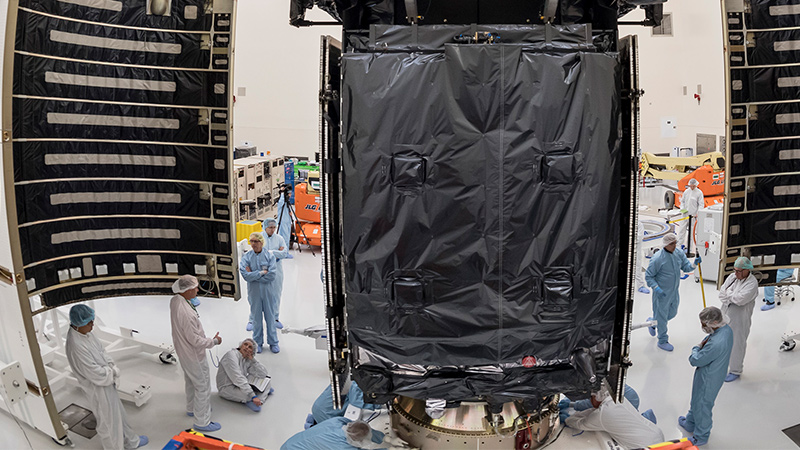Stay Up to Date
Submit your email address to receive the latest industry and Aerospace America news.
Revamped Air Force space center central to quicker delivery of successors to Space-Based Infrared System satellites
COLORADO SPRINGS, Colo. — U.S. Air Force Secretary Heather Wilson on Tuesday announced a reorganization of the Space and Missile Systems Center with the aim of getting missile warning satellites to orbit years sooner than she said today’s acquisition processes and bureaucratic structure would permit.
At issue is pace of developing the Next Generation Overhead Persistent Infrared constellation, the spacecraft that would pick up missile warning duties from today’s Space-Based Infrared System satellites. SBIRS detects the heat from missile or rocket launches and cues up the country’s anti-missile rockets if necessary.
The U.S. Air Force fiscal 2019 budget would cancel the seventh and eight satellites in the SBIRS series, and divert the funds toward development of the next generation satellites.
Wilson and Will Roper, the Air Force assistant secretary for acquisition, technology and logistics, told reporters during the Space Symposium that reforms to the acquisition process are aimed at building and delivering each next generation satellite to orbit in five years, instead of the nine it took to deliver a SBIRS satellite.
The Space and Missile Systems Center, known as SMC, manages development of satellites and rocket technology from its offices at Los Angeles Air Force Base. The restructuring will be led by the center commander, Lt. Gen. J.T. Thompson, and will include creation of a chief architect position. The Air Force will also create an office to report to the assistant secretary of the Air Force for acquisition with the goal of changing acquisition rules, Wilson said.
“We need to stop going around the bureaucracy and start rewiring,” Wilson said of the Pentagon acquisition process, adding that there will not be a “lengthy analysis of alternatives” for the next generation missile warning satellites.
Roper told reporters that delivering a follow-on to SBIRS to orbit within five years is “aggressive,” but cited the need to be ambitious because when the Pentagon sets an acquisition deadline and says, “we’re confident we can reach it, sometimes we don’t.” The definition he gave reporters for the starting point of that five-year goal is “once the program manager has the reins, and the reins means that they have a vendor that they’re working with.”
A clear priority is to make the next generation missile warning satellite to replace SBIRS “more defendable” against disruption or destruction than SBIRS, said Air Force Chief of Staff Gen. Dave Goldfein during a press conference. Wilson said the successor to SBIRS will include “known sensors” and “a common bus” or frame for the satellites. She said that details about how to better protect the satellites against attacks are still in the research and development stage.
“They might be able to maneuver out of the way,” she said of potential means for the new satellite to defend itself. “They might have more fuel on board.”
Wilson mentioned the need for the satellite network to continue to warn of missile attacks even if one satellite is taken out. Putting the missile warning satellites in a mix of different orbits was an option mentioned by Roper to protect against attacks, but he said he was “not ready to say what we think the right mix is.”
“There are benefits to having things in LEO, there are benefits to having things in GEO, there are benefits to having things in highly elliptical orbits,” Roper said. “We need things that work together to give us a resilient architecture.”
Her roundtable with reporters previewed a speech she gave later on Tuesday to symposium attendees in which she stressed the importance of coordinating with allies amid what she said was research in Russia and China on ways to “disable our satellites.”
“We built exquisite glass houses in a world without stones,” she said in prepared remarks for her speech about potential threats the U.S. has not faced in space before. “We must go faster in our drive to defendable space.”
About Tom Risen
As our staff reporter from 2017-2018, Tom covered breaking news and wrote features. He has reported for U.S. News & World Report, Slate and Atlantic Media.
Related Posts
Stay Up to Date
Submit your email address to receive the latest industry and Aerospace America news.





